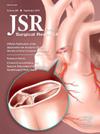Standardization of Narcotic Prescriptions in Minimally Invasive General Surgery Procedures
IF 1.8
3区 医学
Q2 SURGERY
引用次数: 0
Abstract
Introduction
The opioid crisis is a major public health issue, and postoperative opioids play a unique role. Many institutions have implemented standardized protocols to decrease excess opioids available. The objective of this study was to establish a standardized pain protocol for common surgical procedures and assess postoperative pain control.
Methods
This is a prospective observational study based on the Michigan Opioid Prescribing Engagement Network network guidelines which provides prescription recommendations for surgical procedures. We evaluated all laparoscopic/robotic cholecystectomy, appendectomy, and all herniorrhaphies. Patients were prescribed a predetermined number of narcotics by procedure as part of a multimodal pain regimen. A survey was conducted within 14 d postoperatively to assess pain control and narcotic utilization.
Results
A total of 442 patients were included from July 1, 2022 to October 28, 2022. Survey response was 40% (178/442) with 56% (249/442) prescribed per protocol. Fewer patients prescribed per protocol required refills, 9.6% (24/249) compared to 18.1% (35/193) (P = 0.007) without protocol. Patients reported taking significantly fewer narcotics with the protocol versus without (median = 5.0 versus 10.0, P < 0.001). The median number of narcotics taken were 5.5 for appendectomy, 7.0 for cholecystectomy, and 9.0 for herniorrhaphy. There was no difference in pain control when comparing patients with and without protocol (91.1% versus 90.5%, P = 1.0).
Conclusions
This study demonstrated that postoperative opioid prescriptions can be decreased by implementing a standardized protocol incorporating a multimodal regimen while adequately controlling pain following surgery.
微创普外科麻醉处方规范化研究。
阿片类药物危机是一个重大的公共卫生问题,术后阿片类药物发挥着独特的作用。许多机构已实施标准化方案,以减少可用的过量阿片类药物。本研究的目的是为常见的外科手术建立一个标准化的疼痛方案,并评估术后疼痛控制。方法:这是一项基于密歇根阿片类药物处方参与网络网络指南的前瞻性观察研究,该指南为外科手术提供处方建议。我们评估了所有腹腔镜/机器人胆囊切除术、阑尾切除术和所有疝修补术。作为多模式疼痛治疗方案的一部分,患者通过手术处方预定数量的麻醉剂。术后14 d内进行调查,评估疼痛控制和麻醉使用情况。结果:2022年7月1日至2022年10月28日共纳入442例患者。调查应答率为40%(178/442),每个方案规定了56%(249/442)。按方案就诊的患者需要重新就诊的较少,为9.6%(24/249),而无方案的患者为18.1% (35/193)(P = 0.007)。患者报告说,与未使用麻醉药物相比,使用麻醉药物的患者明显减少(中位数= 5.0 vs 10.0, P)。结论:本研究表明,在充分控制手术后疼痛的同时,通过实施一种包含多模式方案的标准化方案,可以减少术后阿片类药物处方。
本文章由计算机程序翻译,如有差异,请以英文原文为准。
求助全文
约1分钟内获得全文
求助全文
来源期刊
CiteScore
3.90
自引率
4.50%
发文量
627
审稿时长
138 days
期刊介绍:
The Journal of Surgical Research: Clinical and Laboratory Investigation publishes original articles concerned with clinical and laboratory investigations relevant to surgical practice and teaching. The journal emphasizes reports of clinical investigations or fundamental research bearing directly on surgical management that will be of general interest to a broad range of surgeons and surgical researchers. The articles presented need not have been the products of surgeons or of surgical laboratories.
The Journal of Surgical Research also features review articles and special articles relating to educational, research, or social issues of interest to the academic surgical community.

 求助内容:
求助内容: 应助结果提醒方式:
应助结果提醒方式:


